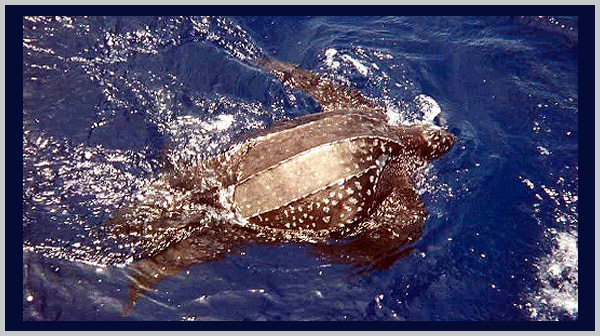
Leatherback Sea Turtle
Name: Leatherback Sea Turtle (Dermochelys coriacea)
Conservation Status: Vulnerable (2021 IUCN Red List)
Population Estimate: Decreasing
Range: Tropical and Temperate Oceans Globally
Threats: Ocean Pollution / Fishing / Temperature Extremes / Habitat Shifting
Once a male leatherback sea turtle struggles from its egg and makes its way to the sea as a 4-inch (10 cm) hatchling, it may never again return to land during its 80-year lifetime. Although they are air-breathing animals born on land, leatherbacks, like all sea turtles, spend their lives in the ocean. Females return to land only to lay their eggs.
Species Description and Range
The leatherback sea turtle is the largest sea turtle. It can grow up to 6.5 feet (2 m) long and weigh 1,400 pounds (636 kg). The leatherback gets its name from its shell, which is like a thick leathery skin, with the texture of hard rubber.
The leatherback sea turtle is a circumglobal species, meaning that it can range throughout almost all the oceans of the world. It nests on tropical beaches in the Atlantic, Indian, and Pacific Oceans. Once abundant throughout the world’s oceans, all eight species of sea turtles are now vulnerable, endangered or critically endangered.
Natural History
Leatherback sea turtles are unique among sea turtles in that their primary food is jellyfish. They also will eat fish, mollusks, squid, sea urchins, and other marine creatures. Adult leatherbacks ply the seas alone, except on occasion gathering to feed in areas with large numbers of jellyfish.
Leatherback sea turtles require warm tropical beaches to incubate their eggs. After mating with a male just offshore, the female waits for nightfall to clamber up the beach, dig a shallow pit in the sand, and deposit her eggs. The female then buries the eggs with her hind flippers and compacts the sand with the weight of her body before crawling back to the sea. Although a female may lay as many as 100 to 150 eggs at time, only a few will survive to grow to adulthood and breed.
Causes of Endangerment
Overexploitation
Sea turtle eggs are a prized food for humans and animals alike. They are easy prey, simply waiting to be dug up once the female turtle returns to the sea. Turtle eggs are used in traditional Asian medicines, and in most parts of the tropical world the eggs are an important part of local diets. Latin Americans covet sea turtle eggs as an aphrodisiac and energizing protein.
Humans have long hunted adult sea turtles for food and for their shells and other parts. In Indonesia, for example, shops are full of turtle souvenirs, turtle-skin bags, jewelry made from shells, and stuffed turtles, all of which are marketed to tourists. Sea turtles have suffered from the growing taste for turtle soup, considered a delicacy in Europe.
Habitat Loss
Sea turtles have used the same nesting beaches for thousands of years. The nesting beaches turtles prefer are often the same beaches most heavily used by people, and nesting turtles are easily disturbed by noise and bright lights. All over the world, hotels, restaurants, and homes have encroached on turtle nesting beaches.
Irresponsible Fishing
Because sea turtles make lengthy migrations from hatching beaches to feeding grounds and back, they are exposed to a wide variety of threats at sea. Pacific loggerhead sea turtles, for example, hatch on Japanese beaches and then swim 7,500 miles (12,000 km) to favored feeding grounds off Baja California.
Pollution
Their preference for jellyfish makes leatherback sea turtles susceptible to another threat: floating plastic garbage in the oceans. Nearly 50 percent of leatherbacks recently studied had plastic bags or cellophane lodged in their stomachs or intestines. Dead sea turtles have been reported containing everything from pieces of plastic milk jugs to bits of balloons, items likely ingested when mistaken for jellyfish.
Conservation Actions
Trade Regulation
The United States and 115 other countries have banned the import or export of sea turtle products through CITES. However, the pressures on sea turtles are not abating and some illegal trade in turtle products continues. Although attempts are being made to control international trade, localized exploitation of turtles and eggs at the nesting beaches is still a problem.
Protection of Nesting Turtles, Eggs, and Hatchlings
Hatcheries and head-starting are two programs aimed at increasing survival of sea turtles in the wild. Hatchery programs are intended primarily to protect eggs from predators. The programs typically consist of gathering eggs from the beach and reburying them in a fenced enclosure.
After the eggs hatch, the hatchlings are released onto the same beach from which the eggs were gathered. Head-starting projects go one step further. After collecting and hatching eggs from the wild, the sea turtles are reared in captivity for nine months to a year. Once the young turtles have reached a size more able to survive predation, they are released onto their natal beaches.
Captive Breeding
The leatherback sea turtle is not easily kept in captivity. Because it is adapted to life in the open sea, the leatherback has no “reverse gear” and will repeatedly swim into any obstacle in its path, including the walls of a holding tank. Other sea turtles have fared better in captivity and perhaps breeding programs can improve their chances for survival.
Question for Thought
Some scientists believe it is too late to save the Kemp’s ridley sea turtle, the world’s most endangered sea turtle. Although there are nearly a thousand Kemp’s ridleys alive, only a few hundred are females, from several different nesting beaches. Why would the low number of females be of particular concern?
What do you think of the idea of raising sea turtles on farms to provide shells and meat? Does this practice help or hinder the survival of wild sea turtles?
Explore:
Related Classroom Activities
[CS1-1,CS1-4,CS1-9, General]
Click here for the Endangered Species Classroom Glossary